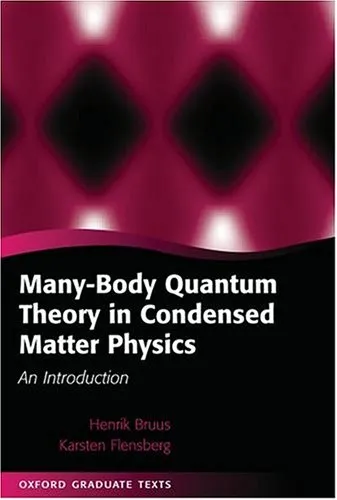Many-body quantum theory in condensed matter physics
4.4
بر اساس نظر کاربران

شما میتونید سوالاتتون در باره کتاب رو از هوش مصنوعیش بعد از ورود بپرسید
هر دانلود یا پرسش از هوش مصنوعی 2 امتیاز لازم دارد، برای بدست آوردن امتیاز رایگان، به صفحه ی راهنمای امتیازات سر بزنید و یک سری کار ارزشمند انجام بدینکتاب های مرتبط:
Persian Summary
خلاصه جامع کتاب
کتاب "Many-body quantum theory in condensed matter physics" نوشته Henrik Bruus و Karsten Flensberg یکی از منابع بسیار معتبر و جامع در زمینه فیزیک حالت جامد است که به بررسی و تحلیل نظریههای کوانتومی در سیستمهای چندذرهای میپردازد. این کتاب به دانشجویان و محققین این حوزه کمک میکند تا درک عمیقی از رفتار کوانتومی مواد مختلف به دست آورند.
این کتاب سه بخش عمده دارد: مقدمهای بر نظریه کوانتومی بسیاریجسمی، کاربرد این نظریه در سیستمهای فیزیکی واقعگرا، و بررسی جزئیات محاسباتی و تکنیکهای عددی مربوطه. با ارائه مفاهیمی مانند Fermi liquid، Green's function و دیاگرامهای Feynman، خوانندگان به سرعت با ابزارهای محاسباتی و نظری لازم برای تحلیل مسائل پیچیده در فیزیک حالت جامد آشنا میشوند.
نکات کلیدی
- فهم فرایندهای کوانتومی در سیستمهای پیچیده با جزئیات کامل.
- ارائه تکنیکهای پیشرفته برای حل مسائل در فیزیک حالت جامد.
- بحثهای جامع پیرامون نظریههای Fermi liquid و خواص الکترونهای وابسته به هم.
- استفاده از Green's function برای محاسبات دقیق در سیستمهای کوانتومی.
- ارائه دیاگرامهای Feynman به عنوان ابزارهای گرافیکی برای حل مسائل پیچیده.
جملات معروف از کتاب
"تئوری بسیاریجسمی کوانتومی نه تنها ابزار مهمی در فیزیک حالت جامد است، بلکه مرزهای تازهای از فهم ما را نسبت به رفتارهای کوانتومی معرفی میکند."
"مواد و سیستمهای مختلف همواره قوانین پایهای فیزیک کوانتومی را به چالش میکشند و شناخت آنها نیازمند بررسی ابزارهای پیچیده و دقیق محاسباتی است."
چرا این کتاب مهم است؟
کتاب "Many-body quantum theory in condensed matter physics" نقش حیاتی در آموزش و پژوهش فیزیکدانی دارد که میخواهند در زمینه رفتارهای سیستمهای کوانتومی پیچیده تخصص کسب کنند. این کتاب دانشجویان را به چالشهای نظری و تجربی در فیزیک حالت جامد راهنمایی میکند و به آنها ابزارهای لازم جهت تحلیل و درک عمیقتر را فراهم میآورد. با ارائه روشهای محاسباتی نوین و بررسی مثالهای واقعهگرا، این کتاب توانسته است تا به یکی از منابع اصلی و اساسی در دانشگاههای معتبر جهان تبدیل شود. با درک مفاهیم این کتاب، محققین توانایی تحلیل رفتارهای مختلف مواد و ایدهپردازی برای تحقیقات جدید را خواهند داشت.
Welcome to a sophisticated exploration of the quantum world through the lens of many-body quantum theory in condensed matter physics. In this thorough introduction, we delve into the depths of quantum mechanics and condensed matter physics to provide a comprehensive understanding of the intricate interactions that define this realm.
Detailed Summary of the Book
The book 'Many-body Quantum Theory in Condensed Matter Physics' serves as a crucial resource for those with a keen interest in the quantum mechanics of condensed matter. It starts by establishing foundational knowledge, covering basic quantum mechanical principles and advancing towards more complex concepts involving interacting quantum systems. The text intricately weaves theoretical development with practical application, situated within the broader context of condensed matter. Topics such as Fermi gases, Bose-Einstein condensation, superconductivity, and magnetism are thoroughly explored. We include robust discussions on the Hubbard model and Quantum Hall effects, ensuring a well-rounded grasp of the subject. The book culminates in an exploration of non-equilibrium phenomena, offering insight into development areas such as quantum computing and quantum materials. Designed to engage both seasoned physicists and those newer to the discipline, our book meticulously articulates the mathematical frameworks and experimental methods underpinning modern condensed matter physics.
Key Takeaways
- Gain a comprehensive understanding of the fundamental and advanced aspects of many-body quantum theory.
- Develop the ability to apply theoretical frameworks to solve complex problems in condensed matter physics.
- Understand and analyze significant phenomena such as superconductivity and the Quantum Hall effects.
- Explore the intersection of theoretical predictions and experimental research, preparing for future advances in quantum technologies.
Famous Quotes from the Book
"The essence of many-body quantum physics is that understanding the collective behavior of a multitude of particles often reveals fundamentally new physical phenomena, which cannot be deduced simply by extrapolating the properties of individual particles." - Henrik Bruus, Karsten Flensberg
"The strength of many-body theory lies in its ability to provide unified explanations and predictions across a variety of systems, highlighting the universal nature of underlying physics." - Henrik Bruus, Karsten Flensberg
Why This Book Matters
As the field of condensed matter physics continues to grow and evolve, understanding many-body quantum theory becomes increasingly critical. This book offers a robust framework for navigating the complexities of the quantum world, providing insights that extend beyond academia into practical, real-world applications. By bridging the gap between theoretical concepts and practical implementations, the book is an indispensable resource for anyone participating in the advancement of quantum science and technology. Its detailed examination of crucial phenomena in condensed matter physics sets the foundation for innovations in fields such as material science, nanotechnology, and quantum computing. Whether you are a researcher, student, or professional, this book equips you with the necessary tools to contribute to and thrive in one of the most dynamic areas of modern physics.
دانلود رایگان مستقیم
شما میتونید سوالاتتون در باره کتاب رو از هوش مصنوعیش بعد از ورود بپرسید
دسترسی به کتابها از طریق پلتفرمهای قانونی و کتابخانههای عمومی نه تنها از حقوق نویسندگان و ناشران حمایت میکند، بلکه به پایداری فرهنگ کتابخوانی نیز کمک میرساند. پیش از دانلود، لحظهای به بررسی این گزینهها فکر کنید.
این کتاب رو در پلتفرم های دیگه ببینید
WorldCat به شما کمک میکنه تا کتاب ها رو در کتابخانه های سراسر دنیا پیدا کنید
امتیازها، نظرات تخصصی و صحبت ها درباره کتاب را در Goodreads ببینید
کتابهای کمیاب یا دست دوم را در AbeBooks پیدا کنید و بخرید
سوالات پرسیده شده از این کتاب
1350
بازدید4.4
امتیاز0
نظر98%
رضایتنظرات:
4.4
بر اساس 0 نظر کاربران
Questions & Answers
Ask questions about this book or help others by answering
No questions yet. Be the first to ask!














